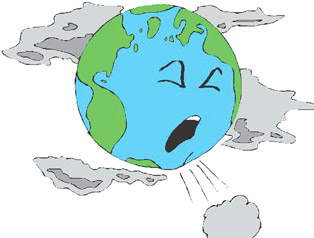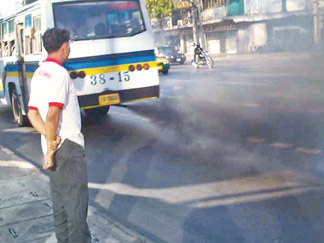Unroadworthy vehicles cause health hazards
By Dhaneshi Yatawara
Evaluating recent inspections the office of the Registrar of Motor
Vehicles have identified that many vehicle repair technicians are not
sufficiently skilled in tuning a vehicle to proper levels of the Vehicle
Emission tests in Sri Lanka. This alarming discovery is leading to a new
step in the Vehicle emission testing in Sri Lanka. The office of the
Registrar of Motor Vehicles (RMV) plans to conduct a special training to
selected motor technicians from the entire country with the help of the
German Tech.
|

Donít let the earth cough |
Vehicle emission testing is stringently carried out amidst various
controversies. This is a program aimed at making the nation healthy. The
controlling mechanism is to create better living conditions for the
people of this country and the future generation.
Did you know how much pollutants are added to the air with vehicle
emissions? Carbon Monoxide, a main component in vehicle emissions is
known as a silent killer. It's an odourless colourless vapour in all
vehicle emissions. Hydrocarbons, from the half combusted fuel and oil
get released in to the air. Specific micro particles emitted with the
vehicle smoke, specially in diesel vehicles are tiny elements polluting
the air in a big way. Sulphur Dioxide, Nitrogen Oxide are the other
noted main air pollutants in the vehicle emissions. All these are highly
toxic substances that will not only make the present world sick but the
future as well.
According to the Air Resource Management Centre (AirMAC) of the
Ministry of Environment vehicle emissions are the main factor polluting
the air we breathe. Accordingly these pollutants when reaching the lungs
start damaging the tissues, and medically it is proven damaged lung
tissues are irreparable. This would make any man, woman or child a
terminal patient with respiratory problems.
These toxics do not stop there. When absorbed in to the blood stream
it can create constant headaches, dizziness, nausea and going further to
many illnesses related to the nerve system and in the case of long term
constant exposure even damage kidneys and liver. This is what happens
when the air we breathe gets poisoned with pollutants from vehicle
emissions.
Today we are conducting the vehicle emission program in eight
provinces of the country in partnership with the private sector," said
Project Director of RMV Emission Testing Program A.W. Dissanayake.
"Today people are more aware of the facts and are eager to pass the
test in the legitimate way except for a few cases," Dissanayake said. As
he further said, proper practices of maintaining a vehicle has been
inculcated among the public. "Proper maintenance and fine tuning of the
vehicle leads to efficient combustion of fuel, thus avoiding unnecessary
over usage of fuel," he said. This leads to extending the life of a
vehicle.
|

Pollutants are added to the air with vehicle emissions |
Implementing the vehicle emission test is possible through several
legal provisions that exist in the country. The 1951 Motor Vehicle Act
and regulations of the 1952 Motor Vehicle Act can be recorded as the
oldest.
The 1981 amended Motor Vehicle Act and the No.8 of the 2009 Amended
version of the Act also provides legal provisions to implement the
vehicle emission testing, as Dissanayake said. In 1983 these regulations
have been gazetted under the Gazette number 246. In the extraordinary
gazette issued on 2008.07.09 the Environment Act - No.47 1980 and No.
1533/17 , vehicle emission testing has been mentioned. Under the
paragraph 29 of the Motor Vehicle Act mentions that in order to obtain
Revenue permit, Vehicle Emission certificate is needed along with the
Eligibility certificate. It also gives permission to the authorities to
give the above certification combined.
Paragraph 194 of the Motor Vehicle Act gives power to the
Commissioner General of Motor Vehicles to inspect any vehicle.
The Paragraph 198 of this Act gives power to Motor Vehicle Inspectors
of the RMV to inspect vehicles at any given moment on the road.
Under the Motor Vehicle Act (paragraph 196 B) imposes a fine of Rs.
20,000 - 25,000 for issuing emission and eligibility certificates
illegally. This also gives provision to suspend the authority given to
issue such certification.
What do a vehicle owner have to do to maintain the vehicle in order
to become the least air polluter?
Fine-tune the carburetor periodically. Air Filter, Fuel Filter and
Engine Oil Filter need to be changed according to manufacturers'
instructions. Components like plugs, electronic systems, cooling
systems, silencer barrel, and ignition system need to be checked and
repaired when necessary. Servicing Injector pumps and correctly
pressurising them also help make the vehicle more efficient. Not
overloading a vehicle is another main factor if you want the vehicle to
live long.
"These regulations cannot be considered solely as controlling
mechanisms. This benefits the vehicle owner," Dissanayake said.
A well maintained vehicle means long life for the engine and high
efficient fuel usage means less fuel burnt, controlling the usage of
petrol and diesel imported to the country thus saving a significant
portion of foreign exchange. These steps improve the overall quality of
the vehicle while making a safe environment of us as well as the future
generation.
"We see that people are more interested in getting these certificates
in the normal procedure rather than trying to overlook the rules and get
permission. This is still a new system, specially in a developing
country like ours. Thus, it will take some time to be inculcated in to
the Sri Lankan culture," he said.
|


